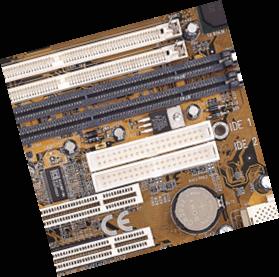
Many of the previous year's boards carried on well into the new year, including the Epox, Soltek and FIC AZ-11 Socket A boards, the PA-2013 and the astonishingly long-lived VA-503+ which, incredibly, ran on into its fourth year and was still selling well. It was rare to use a 503 in a new-build system by this time, but we still popped one into an older system by way of upgrade or repair on a daily basis — if we could have got K6-2/500s or K6-IIIs we still would have done so right into mid-2002. In the days when Super 7 was king, the 503 was the best selling of our several Super 7 boards, and while Socket A accounted for well over half of all motherboard sales by mid-year, the 503, our last remaining mainstream Super 7 board, was still the best selling individual board we carried. One hundred percent of a niche can be more than twenty percent of the mainstream.
In Socket A, the Epox was most popular, but we used the Soltek, FIC AZ-11 and the Gigabyte regularly too, plus occasional Socket 370 boards for Celerons and Pentium IIIs — very few of these though. In years gone by, people used to come in asking for a Pentium and usually walk out with a 6x86 or AMD-based system. But not in 2001: if they come in asking for a particular chip, it was nearly always an Athlon, or perhaps a Duron.
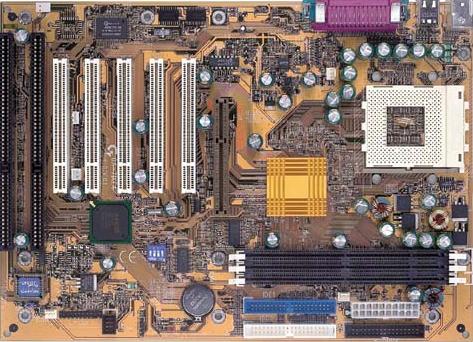
Gigabyte 7IXE4
An excellent board, and unusual in that it didn't use one of the ubiquitous VIA chipsets, but rather AMD's own 750.They must have been on the market for some time before we tried them, and we rather wished we'd spotted them earlier, as they had several refreshing features.
Where most boards had chipset-embedded AC-97 sound by this time (which cost almost nothing and was perfectly adequate for many users) these were a plain vanilla board: no sound, no bull. We liked that. Gigabyte had the common sense to leave out the useless AMR riser slot and have an extra ISA slot instead — twin ISA slots: there was another rarity. As we see it, the first ISA slot was a necessity; the second one, though it would probably never be used, just gave us extra confidence that here was a board we could rely on to cope with all sorts of unexpected circumstances. And the GA-7IXE4's AMI BIOS was much nicer to use than the all-too common Award one, which was competent but very clumsy.
Gigabyte gave the IXE4 all the common standard features, including good hardware management, twin serial ports, and the usual slew of gimmicky wake-up and shut-down stuff. The board itself was well laid out, a little larger than was common (note the third row of screw holes near the front of the board) and very easy to work on — except for an absurdly obscure connector block, which was not only very badly labelled, but wrongly described in the manual too! Later on, we were to discover that Gigabyte had started using this same layout in all their boards some time before, as had two or three other makers, so we have softened in our dislike of it. It remains illogical and non-intuitive but at least it's the same illogical and non-intuitive layout on a lot of different boards, which makes it easy to memorise. If you are looking at one of these and trying to work out where the power switch connector goes, don't worry — we couldn't work it out either! (Gigabyte have never been able to produce a decent manual, despite making them bigger and more detailed every year. In our own twisted way, we sort of liked the fact that the 7IXE4 maintained this long-standing tradition.)
In short, a classic Gigabyte board, with the classic Gigabyte faults, which were forgivable, as these aside it was simple, robust, and excellent value for money.
- CPU support: Duron, Thunderbird A to 1GHz
- Speed: 200MHz.
- Slots: 2 ISA, 5 PCI, AGP, 2 USB ports.
- RAM: 3 168-pin PC-133 SDRAM, up to 768MB SDRAM.
- IDE: 2 ATA-66.
- Chipset: AMD 750, AMI BIOS.
- Best With: Duron.
- Status: Legacy.
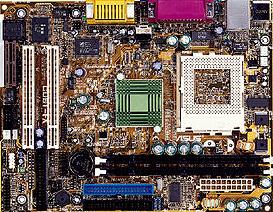
ASUS CUSI-FX and CUSI-M
An odd pair of boards, but representative of the way the entry-level was headed. Both were based on the SiS 630E all in one integrated chipset. But why two boards? What is the difference? Very little in fact. The CUSI-M was Micro-ATX form (7 by 9.6 inches) while the CUSI-FX was Flex-ATX (7 by 9 inches). The slightly larger CUSI-M (below) had an extra PCI slot and could do suspend to RAM (as if anyone cared) but otherwise the boards were identical. Even the price was the same.
We hadn't sold a new Celeron system for over a year by mid 2001, but we still traded them in from time to time, and we bought these boards to use up some surplus traded Celerons in the 400 and 500MHz range. On paper they should have been ideal for that job: inexpensive, everything integrated, and the peace of mind that goes with ASUS quality.
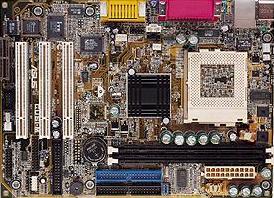
We had rather hoped for a classic cheap and reliable SiS-based ASUS integrated board, in the tradition of the SP97-V. But these were not very impressive. Perhaps we were just unlucky, but after buying two of each, we had two in-service failures and had to immediately return the other two for warranty replacement: one of our two CUSI-Ms had no power at all, and one of our CUSI-FXs produced Windows protection errors on shutdown. The replacements were OK so maybe it was just a statistical blip, but it was not a great start, and not what we expected from ASUS. Adding these to our less than happy experiences with their Athlon boards, we eventually had to face the fact that it was time to cross ASUS off our list of preferred board makers.
- CPU support: Celeron, Pentium III, Cyrix III
- Speed: 66/100/133MHz.
- Slots: CUSI-M: 3 PCI, 5 USB. CUSI-FX: 2 PCI, 2 USB. No AGP, no ISA.
- RAM: 2 168-pin PC-133 SDRAM, up to 1GB.
- IDE: 2 ATA-100.
- Chipset: SiS 630E, Award BIOS.
- Best With: Celeron.
- Status: Legacy.
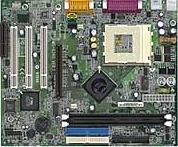
MSI 6340-M
An integrated board for Socket A based on VIA's KM-133 chipset — much the same as a KT-133 but with S3 UMA video function added. Rather cramped because of the Micro-ATX format, but perfectly workable. Putting the video on the main board saved around $45 and while it sapped performance, a Duron-equipped MS-6340 was still more than a match for the 66MHz bus Celerons of the day, and although the 6340 cost about $40 more than an integrated Socket 370 board, the Duron CPUs were cheaper so the total cost was much the same.
We liked the peace of mind that having an AGP slot gives: being able to upgrade to a stand-alone video card is important and worth a few extra dollars. Boards like these were a rational choice for many jobs. Just the same, we couldn't escape the feeling that they were a bit of a toy motherboard, just too small and too integrated to be convincing.
- CPU support: Duron, Athlon to 1GHz
- Speed: 200MHz.
- Slots: 3 PCI, AGP, 4 USB, 1 serial, integrated sound and video.
- RAM: 2 168-pin PC-133 SDRAM, up to 1GB.
- IDE: 2 ATA-100.
- Chipset: VIA KM-133, Award BIOS.
- Best With: Duron.
- Status: Legacy.
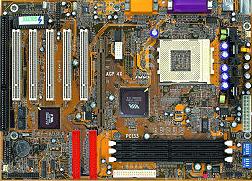
Soltek SL-75KAV
Our stand-put most popular main board for most of the year, and with good reason. These were an outstanding product.
Using the VIA KT133A chipset instead of the older KT133 allowed a jump in bus speed from 200 to 266MHz. This, in turn, allowed you to use the new 133MHz bus Athlon C, the fastest CPU on the planet at this time. But even with a more pedestrian chip (a Duron or an Athlon 900, say) the SL-75KAV was a delight. It was well laid out with plenty of room to work with, had the optimal expansion slot arrangement — AGP, five PCIs and an ISA, with no useless, space-robbing AMR slot — and equipped with an Athlon Thunderbird C the SL-75KAV was awesomely fast.
75KAVs were a little more expensive than a cheap 200MHz KT-133 board, but very much worth it. As always, Soltek's software bundle was good value, their documentation glossy but sensible, and the driver CD organised properly with no odd-ball traps for the unwary. Our only quibble was the layout of the switch and LED connectors. No-one, it seems, can get these right except for Iwill and Epox.
- CPU support: Duron, Athlon, Athlon XP
- Speed: 200 or 266MHz.
- Slots: 5 PCI, AGP Pro, ISA, 4 USB, 2 serial, integrated sound.
- RAM: 3 168-pin PC-133 SDRAM, up to 1.5GB.
- IDE: 2 ATA-100.
- Chipset: VIA KT133A, Award BIOS.
- Best With: Athlon Thunderbird.
- Status: Legacy.
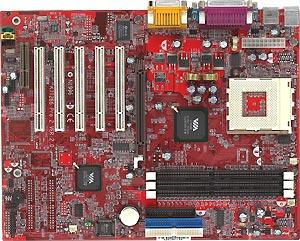
MSI K7T266 Pro 2 (MS6380)
The first of the VIA KT266A based boards to arrive. Teamed with DDR RAM and an Athlon XP, these were awesomely fast. The initial uptake of DDR RAM was quite slow. There were a combination of reasons for this. First, in the early days it made less difference to performance than you would have expected: the processors and boards available were not taking full advantage of it. Second, there was the outstanding VIA KT-133A chipset, which gave most of the performance benefits of DDR using ordinary SDRAM. Third, the initial batch of DDR chipsets were lack-lustre (the Ali and the VIA KT-266), expensive (AMD 760), or late to market (VIA KT-266).
In about October of 2001, several things happened to change this: the excellent SiS DDR chipset, though more a threat than a reality in this market, started to drive prices down; the Athlon XP arrived, and VIA finally got their DDR chipset right, in its second incarnation as the KT-266A. With the speed of the hard-to-get SiS chipset, the traditional good VIA pricing, and stability approaching the AMD 761, this was a definite winner.
The MSI implementation of the KT266A is impressive on first sight. That vibrant red circuit board just can't be mistaken. All the usual features are present, they have MSI's normal impressive packaging and documentation, and the driver CD is both comprehensive and well organised. On further experience, we were a little concerned about these. Unlike the other KT-266A boards we have used since, they are very fussy about RAM, particularly if you add a second DIMM. In the end we didn't have to return any of our K7T266 boards; we discovered that by choosing the right brand of RAM for them (Crucial) they ran as reliably as we could ask. But with other, equally expensive, equally well-credentialed RAM they gave us trouble. With an Epox or a Soltek, we just plug in any RAM we like and they go. This gives us more confidence in the system's long-term stability. (Again, we should stress that once we matched the K7T266 and the RAM, we have had no trouble at all with them. But given equality in other factors, why buy the fussy board?)
- CPU support: Duron, Athlon, Athlon XP
- Speed: 200 or 266MHz.
- Slots: 5 PCI, AGP Pro, 4 USB, 2 serial, integrated sound.
- RAM: 3 168-pin PC-2100 DDR RAM, up to 1.5GB.
- IDE: 2 ATA-100.
- Chipset: VIA KT266A, Award BIOS.
- Best With: Athlon XP.
- Status: Legacy.
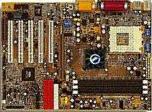
Soltek SL-75DRV2
The second of our KT266A DDR boards and a firm favourite here. Soltek could do very little wrong in 2001, it seemed. These tended to be a fraction cheaper than the MSIs and around the same price as the Epox. After our magnificent run with the older SL-75KAV we took a little while to warm to the DRV2, but having got to know them well we have come to trust them utterly. They were every bit as reliable and fuss-free as previous model, and as Soltek boards always seemed to, came with an excellent set of bundled software too.
- CPU support: Duron, Athlon, Athlon XP
- Speed: 200 or 266MHz.
- Slots: 5 PCI, AGP Pro, 4 USB, 2 serial, integrated sound.
- RAM: 3 168-pin PC-2100 DDR RAM, up to 1.5GB.
- IDE: 2 ATA-100.
- Chipset: VIA KT266A, Award BIOS.
- Best With: Athlon XP.
- Status: Legacy.
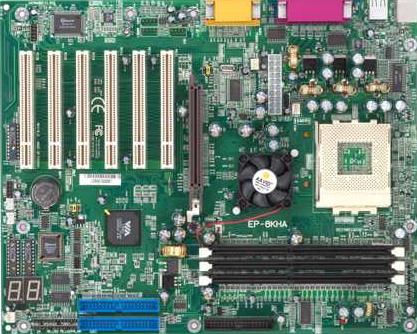
Epox 8KHA+
Quite possibly the best early-model KT266A board of them all. Very hard to decide which was the better of the two, the Epox or the Soltek. We always had one or the other in stock, usually both. The choice between them came down to truly minor matters: which had the better laid-out LED connectors (the Epox), the more sensibly positioned power socket (the Soltek), or the lowest price (not much in it either way). With boards as good as these to choose from, our task was easy: just take the first one you put your hand on.
Just as the Soltek SL-75DRV2 was preceded by their KT-266 equipped SL-75DRV (not listed here because we steered well clear of KT-266 boards), the Epox 8KHA+ was essentially the same as the earlier 8KHA. VIA's first attempt at a DDR chipset, the KT-266, was very late to market, achieved poor benchmark scores, and gathered little praise. This made the debut of the much revised KT-266A all the more impresive: overnight VIA went from being a non-player in the DDR arena to the clear and obvious chipset maker of choice.
- CPU support: Duron, Athlon, Athlon XP
- Speed: 200 or 266MHz.
- Slots: 5 PCI, AGP Pro, 4 USB, 2 serial, integrated sound.
- RAM: 3 168-pin PC-2100 DDR RAM, up to 1.5GB.
- IDE: 2 ATA-100.
- Chipset: VIA KT266A, Award BIOS.
- Best With: Athlon XP.
- Status: Legacy.


